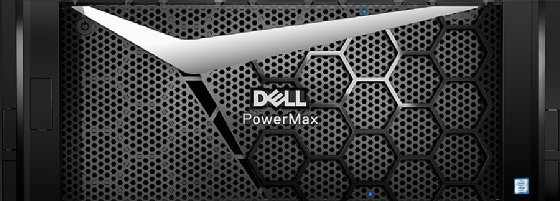
Getty Images
Storage OSes get spotlight at Dell Tech World
Dell storage software superseded any hardware news at the vendor's annual user show, highlighting cybersecurity and emphasizing its commitment to Project Alpine.
LAS VEGAS -- Dell Technologies added more than 500 new software features to its storage portfolio at Dell Technologies World 2022, focusing on security, automation and multi-cloud storage setups.
The company unveiled 120 new software features to Dell PowerStore, its midrange storage array; more than 200 to Dell PowerMax, its high-end array; and over 150 new features to Dell PowerFlex, its software-defined storage.
Upgrades to PowerStore and PowerMax hardware were less sweeping and centered on added performance through better use of the NVMe protocol. PowerFlex added new file services for unified block and file capabilities.
The focus on software was a change of pace for Dell, a company rooted in hardware products and advancements.
"[Dell isn't introducing] really new hardware," said Scott Sinclair, an analyst at Enterprise Strategy Group, a division of TechTarget. "They're playing up their software capability. That was something very key they really want to highlight: There's a ton of software innovation that goes in the boxes."
Storage software in spotlight
Dell's executives emphasized the drive to keep its storage software portfolio "continuously modern," according to Shannon Champion, vice president of primary storage, HCI, CI and product marketing at Dell Technologies. It has invested more than $7.6 billion on research and development and engineering in the last three years.
Dell's PowerStore software 3.0, which was unveiled on the second day of conference, has more than 120 new features that that will be rolled out without disrupting customer production, Champion said. The new version of the OS includes Native MetroSync replication for workloads including file and VMware virtual volumes (vVols) and other high-availability features are new to this version.
Other new replication features for PowerStore center around tighter VMware integration. PowerStore now includes vVols replication as well as VM-level snapshots and fast clones, while providing better vVols latency and performance.

For high-performance demanding workloads, Dell added more than 200 new features to PowerMax, in an update to PowerMax 10.0, the last version of the high-end array's OS. Executives underscored the added security features, which includes cybervaults for both traditional and mainframe deployments as well as the ability to detect cyber attacks with CloudIQ, Dell's analysis and monitoring software. PowerMax can now scale up to 65 million immutable snapshots per array, Champion said.
"It's designed for zero-trust security architectures, and now includes things like multifactor authentication, continuous ransomware anomaly detection and a native air-gapped firewall," Champion said.
PowerMax now has increased efficiency with a 4:1 data reduction for general use and 3:1 for mainframe, Champion said. Dell also added automation in the form of smart provisioning and file replication capabilities.

Already rooted in software, Dell introduced file storage capabilities on PowerFlex for traditional NAS workloads. Combined with the existing block storage, this will provide a unified storage product for customers, Champion said. Storage, compute and lifecycle management were unified within PowerFlex Manager Software, and the software-defined storage saw security updates as well.
"In addition to built-in security and hardening, PowerFlex customers are able to protect and isolate their mission-critical data using PowerProtect cyber-recovery," Champion said.
All the new features have planned availability in the third quarter of 2022 with no added costs to existing customers.
Storage climbing the Alpine
The focus on new storage software builds on Dell's Project Alpine, its initiative to bring Dell's file and block storage software to the public cloud that was announced earlier this year, according to Caitlin Gordon, vice president of product management at Dell Technologies.
Project Alpine enables users take data services on premises and run them in the public cloud by abstracting data from PowerStore and PowerScale to run in the public cloud, bringing a consistent experience across on-premises and cloud environments, she said.
"[Users] can combine the great data services and capabilities of our storage platforms with hyperscalers' great data services like analytics and AI," she said.
At the conference, Dell demonstrated how Project Alpine would work. While the executives didn't draw a direct line from the new software storage features for PowerStore, PowerMax and PowerFlex to Alpine, Alpine will encompass all the new features at some point in the future.
Project Alpine is focused on users who want to run an application a certain way but don't need to know where it is, according to Andrew Smith, an analyst at IDC. All that matters is that it can be seen and interacted with in the same way no matter where it lives.
"What Project Alpine is doing is building out an underlying infrastructure integration to allow applications to run, regardless of whether it's Dell, AWS, Azure," he said. "It doesn't matter what the underlying compute and storage is; Dell can manage it, Dell can move it and the application can run."
Hardly any hardware
Dell also refreshed the hardware its midrange and high-end storage arrays.
For PowerStore, Dell added the latest Intel CPUs and NVMe expansions with support for us to 15.36 TB NVMe SSDs, bringing the total capacity up to 4.7 PB per appliance and 18.8 PB per cluster. With networking, Dell added its new 2-port 100 GbE IO. Combined, the new hardware brought up to 50% performance increase in mixed workloads and up to 60% increase in capacity.
For PowerMax, Dell focused on minimizing latency with its new scale-out NVMe-oF over RDMA.
Both arrays as well as PowerFlex can use NVMe/TCP capabilities, bringing faster connections through existing Ethernet. NVMe/TCP deployments are fully automated, meaning that users need not spend time configuring connections.







